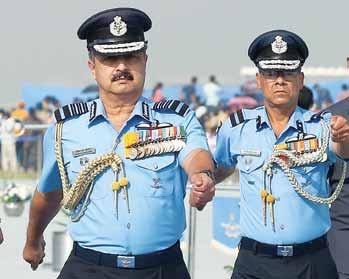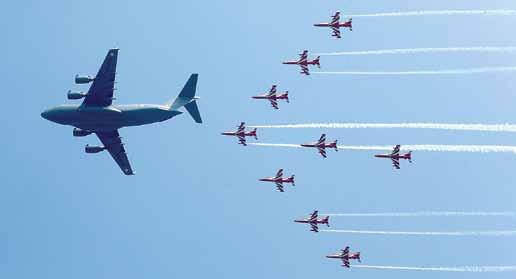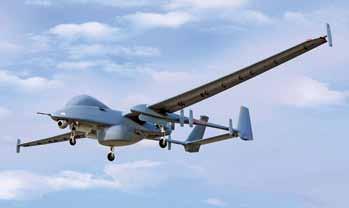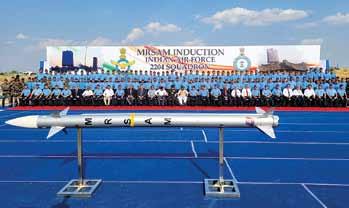
9 minute read
Anniversary Celebrations
Chief of Air StAff Air Chief MArShAl V.r. ChAudhAri ArriVing for hiSiAfdAy AddreSS
IAF SHARP FOCUSSES ON THREAT FROM CHINA
IAF displays show of strength on 89th Air Force Day
By Vishal Thapar
India flexed its air power muscle on the 89th Indian
Air Force (IAF) Day on October 8 under the shadow of the continuing military stand-off with China, with the IAF Chief pledging to defend the nation’s territorial integrity.
“We must demonstrate to the nation that external forces will not be allowed to violate our territory,” Air Chief Marshal Vivek Ram Chaudhari declared in his Air Force Day address at the Hindon airbase on the outskirts of New Delhi.
“The prompt actions in response to developments in Eastern Ladakh were a testament of IAF’s combat readiness,” he said, very clearly identifying India’s principal military challenge.
“Remember that it is our sacred duty to protect our nation’s sovereignty and integrity at any cost and you are to do what it takes to ensure that we do not let the nation down,” Air Chief Marshal Chaudhari exhorted his force.
The IAF lined up its most potent assets for the Air Force Day Parade and carried out an impressive flypast featuring its frontline fighter aircraft.
All unit citations awarded by the IAF Chief were for deterrence action in Eastern Ladakh, the scene of the continuing face-off with China. 47 Squadron equipped with the MiG-29UPG received recognition for its “offensive posture” in the Northern Sector, where it was deployed in May 2020 for extensive Air Defence as well as Air-to-Ground operations at high altitude. 116 Helicopter Unit equipped with the indigenous armed Advanced Light Helicopter Mk IV ‘Rudra’ received the Chief’s citation for deployment in an offensive, high-altitude operations in Ladakh after the Galwan skirmish in May 2020.
“The Unit quickly established the first ever high-altitude Attack Helicopter Detachment in the region and executed day and night operations, including Air to Ground weapons delivery at high altitudes. Operating the indigenous state-of-the-art Rudra, the unit continues to achieve important milestones for the Indian Aviation Industry,” the Unit Citation stated.
The 2255 Squadron Detachment, a frontline OSA-AK-M surface-to-air missile unit, received the recognition for an effective role in its first-ever hi-altitude deployment in a No War No Peace scenario. It was mobilised for Air Defence activation in Ladakh in June 2020 in response to the Galwan stand-off.
“Since then, the Squadron has undertaken various innovations to sustain serviceability and reliability of its (legacy) equipment. This has enabled it to maintain its Operational Readiness in harsh climatic conditions, even through the harsh winter of Ladakh,” the Citation declared.
The Air Chief lauded the force for its massive airlift in support of the national effort to battle the COVID pandemic.
Self-reliance was the other big focus, with “Atmanirbhar

C-17 And SuryA kirAn teAM in forMAtion on iAf AnniVerSAry dAy
aevam Saksham (Self-reliant and Capable) being the IAF’s theme for this year’s anniversary celebrations.
“With the ongoing acquisition of a high percentage of ‘Made in India’ platforms, weapons and combat systems, the IAF stands today on the threshold of an era which will redefine its stature as a potent Strategic Aerospace Force,” the Air Chief said, aligning his force with the ‘Make in India’ agenda.
“The need of the hour is to reassess and realign with emerging trends, in order to gain from ongoing efforts towards greater self-reliance in high tech items. I am happy to report that several projects are well underway for harnessing the potential of Automation, Data Analytics and Artificial Intelligence in order to transform the way we fight future wars,” he said.
Air Chief Marshal Chaudhari also put a premium on out-ofthe-box thinking to counter asymmetries. “I am of the view that while we are actively pursuing self-reliance in hardware, innovative thought has historically been our core strength and I look forward to skilful and creative employment of these capabilities through development of our own unique tactics and ‘out-of-thebox’ operational plans,” he said.
The Air Chief also reminded India’s military of the multipledomain challenges. “The security environment in our region and beyond has been impacted by a complex interplay of geo-political forces. Moreover, the advent of new domains - over and above the traditional domains of land, sea and air - have resulted in a paradigm shift in the way military operations will be conducted. In sync with the changing nature of war-fighting, ongoing capability enhancement in the IAF is aimed at providing the optimum means for employing air power and achieving desired effects across domains - swiftly and decisively.
Seeking to correct the view that the IAF is opposed to the current drive towards jointness among the armed forces and theatre-isation of commands, he described “integrated jointness” as the way ahead.
“It is also our belief that the core competence of each service, indeed, of all organs of national power must be synergised to generate the desired effect and capability. Here, I wish to assure the nation of our unwavering commitment towards delivering joint capability and generating integrated response options as part of a coherent national strategy,” he said, putting nuance to the IAF’s concerns about jointness. The showstopper was the flypast involving 75 aircraft, the number symbolising the 75th year of Indian Independence. The Air Force Day parade and flypast also commemorated 50 years of India’s military victory in the 1971 War. The Gnat fighter, famous as the Sabre Killer in 1971, was at the centrestage of the static display of aircraft. The pick of the IAF’s contemporary fighter fleet, including the Rafale and the Sukhoi-30 MKI, flew the Pratap formation and the Sekhon formation in commemoration of the heroes of the War. Air Chief Marshal Pratap Lal was the IAF Chief while Flying Officer Nirmal Singh Sekhon is immortal for his exploits in taking on six Pakistan Air Force Sabres in a diminutive Gnat in the defence of the Srinagar airbase on December 14, 1971. Sekhon remains the sole winner of the Param Vir Chakra – the nation’s highest wartime gallantry award – from the IAF. Earlier, the Akash Ganga skydiving team jumped in the ‘Tanghail formation’ to commemorate the legendary Tanghail airborne assault by the Indian forces in East Pakistan, opening the doors to Dhaka. The Akash Ganga sky divers jumped from a restored Dakota to recreate the vintage effect. Another distinctive feature was the All unit citations display of the world’s largest khadi Tricawarded by the olour. Made by the Khadi Board, this flag was 225 feet long and 150 feet wide.IAF Chief were for While the aerobatics display by the deterrence action in Eastern Ladakh, Surya Kiran Aerobatics Team (SKAT) and the Sarang Helicopter team lived up to their billing as the traditional the scene of the crowd pleasers, thrilling manoeuvres continuing face-off by the Rafale, Sukhoi-30MKI and the Light Combat Aircraft Tejas was the with China highlight of an impressive airpower demonstration. SP
Enhancing india’s indigEnous dEfEncE capabilitiEs


(Left) IAI Heron; (rIgHt) MrSAM InductIon cereMony
IAI has had a long-standing and fruitful relationship
with India, and for decades, has been a strategic partner with India’s Air Force, Army, and Navy. IAI’s commitment to India’s defence needs are seen in the state-of-the-art systems that IAI has produced for and alongside the Indian defence ecosystem. IAI has prioritised the ‘Make in India’ policy in the many projects, ensuring that local companies and vendors in India have maximum operational independence. IAI’s ability to adapt its technological know-how to India’s specific needs has made the company a natural partner. An array of IAI systems, including IAI’s Heron UAS family, IAI-ELTA’s special mission aircraft, air defence systems, and other systems of systems serve as the right solution for India’s defence needs.
Building on over four decades of expertise, IAI’s Unmanned Aerial Systems (UAS) are a prime example of the company’s state-of-the-art systems. The Heron 1, Heron MK II, and Heron TP are able to navigate extremely diverse regions and operate in challenging conditions. The Heron UAS family can suite military and law enforcement operations – including intelligence gathering, surveying borders, target missions, search and rescue, and others. The Heron UAS allows complex intelligence, surveillance, target acquisition, and reconnaissance (ISTAR) capabilities over any terrain and in any weather conditions, including maritime patrol. The Heron’s sensors feed ISTAR data to the ground segment and tactical-level end users in real-time to provide the customer with an upper hand. Further, IAI’s local customers in India maneuver their own UAS all-level maintenance and receive support from IAI to ensure that the UAS’ potential is maximised. IAI’s commitment to providing the best UAS to its customers is evident in the systems’ success globally and IAI’s capability to adapt the systems to the customer’s needs.
In addition to the UAS Heron family, IAI’s comprehensive range of air defence systems serve as the right solution to India’s air defence needs. IAI state-of-the-art systems, like the MRSAM air and missile defence system, provide a single integrated solution for multiple simultaneous aerial threats from different sources and ranges. The system is tailor-made, and includes the MRSAM Battle Management Center, which creates and manages a unified multi-sensor aerial picture, coordinates the force operation networks and manages the launch arrays, and which is available in naval or land-based configuration. The MRSAM Interceptors have vertical launch capabilities supporting 360° coverage, quick reactions, short minimal ranges and an active high-end RF seeker for targets with low radar cross-sections and high maneuverability. MRSAM’s innovative, software-based approach offers exceptional flexibility in operation and power build-up and ensures simple adaptation to future threats. IAI’s air defence systems like MRSAM are also used as naval applications. Designed with a system of systems approach, IAI’s naval defence solutions integrate sensors, command, control and collaboration, with different types of interceptors for short, medium and long-range intercept, along with gunnery solutions for close-in defence. IAI’s ground-breaking technology is a testament to its advanced know-how, and its development in India shows a clear commitment to supporting the local defence economy.
In addition to UAS and air defence systems, IAI offers a wide range of other solutions, amongst them aircraft conversions. These include special-mission aircraft conversions and modernisations, such as the multi-mission tanker/transport B767 among others. IAI has upgraded thousands of aircraft, enhancing their operational capabilities and enabling operations performance that compares with newer models. This serves as a cost-effective alternative to purchasing extremely costly new helicopters. Further, IAI has in-house capabilities for performing military aircraft overhaul, refurbishment, retrofit, maintenance, repair and upgrade for aircraft from KFIR to F-16. IAI’s commitment to the ‘Make in India’ policy provides the local defence economy to benefit from such projects.
With a commitment to excellence and a proven ability to evolve with the ever-changing needs of the modern battlefield, IAI continues to develop advanced technologies with unmatched capabilities. IAI’s defence solutions elevate its customer’s ability to defend against a broad range of threats and provide the right solutions to the challenges ahead. IAI looks forward to continuing its partnership with the Indian defence ecosystem. SP










